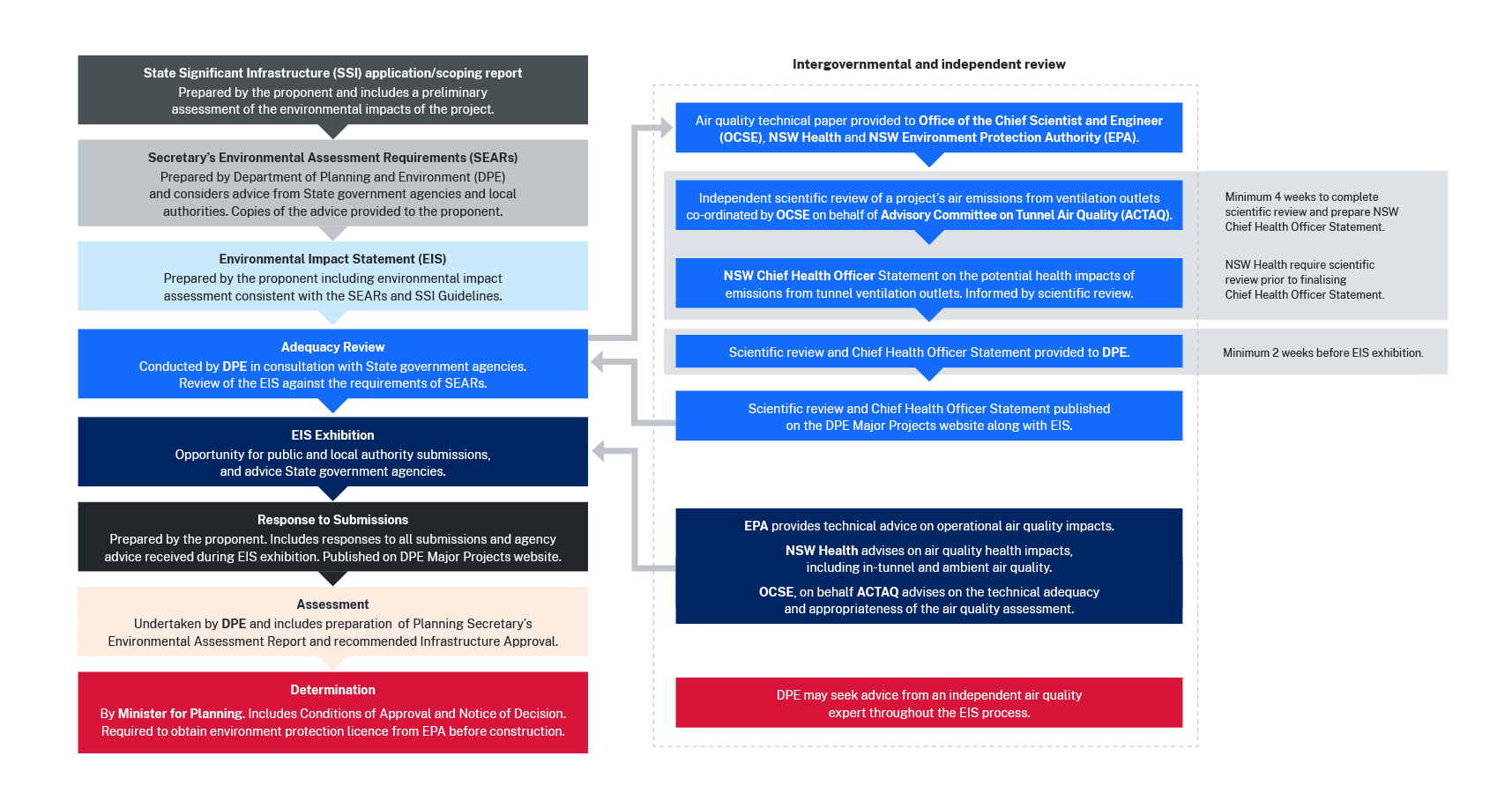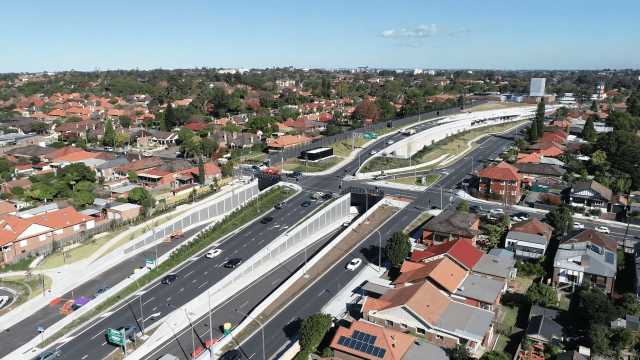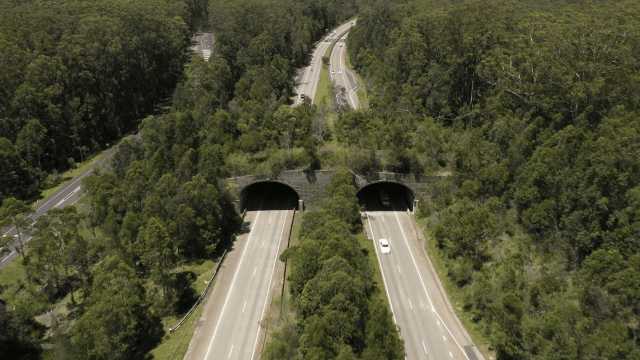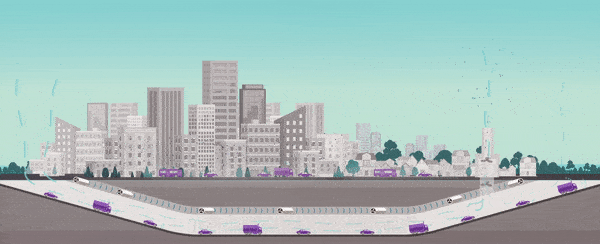Tunnels and ventilation
Why we build road tunnels
We build tunnels to help manage congestion and minimise disruptions to communities. Tunnels enable us to move traffic away from homes and workplaces and reduce stop-start congestion.
Within the tunnel environment, vehicle emissions can be controlled and dispersed more effectively, resulting in little, if any, change in air quality for people living and working near the tunnel.
By relocating surface traffic into tunnels, we can also use more space for things that matter most to communities. Find out more in the Tunnel ventilation and filtration fact sheet.
How tunnel projects are assessed
Securing approval for major road tunnel projects in NSW involves a robust and transparent process. The planning approval process involves a comprehensive review of each individual project to ensure stringent compliance with the highest air quality standards.
The main steps in this approval process are:
The Department of Planning and Environment (DPE), along with other state agencies, assesses each proposal.
The Office of the Chief Scientist and Engineer (OCSE), on behalf of the Advisory Committee on Tunnel Air Quality (ACTAQ), provides a independent and scientific review that focuses on air emissions from ventilation outlets.
The NSW Environment Protection authority (EPA) provides technical advice to the DPE on the impacts of operational air quality.
NSW Health advises the DPE on potential air quality health impacts, including in-tunnel and ambient air quality.
After public engagement and assessment, the Minister for Planning and Public Spaces determines whether the project should be approved.
Once approved, both the DPE and the EPA regulate the construction and operation of the tunnel, ensuring continued compliance with air quality standards.
Tunnel ventilation reforms and State Significant Infrastructure Environmental Impact Statement (EIS) process

Types of ventilation
Road tunnel ventilation systems are designed to maintain air quality inside and outside of the tunnels. The design of the ventilation system and any associated structure is built to meet stringent air quality requirements in NSW.
There are primarily 2 types of systems in use, ventilation outlets and portal emissions, both of which have been shown to be effective in managing emissions and maintaining air quality.
Ventilation outlets
Ventilation outlets are 1 option in maintaining the air quality surrounding tunnels, especially in urban areas.
Fresh air is drawn into the tunnel, which is then moved along the tunnel by a combination of the traffic movement and fans
Ventilation air is extracted from the tunnel through ventilation outlets using powerful fans to disperse the air high into the atmosphere
The outlets are located near tunnel exits, where they can operate most efficiently
Venitlation outlets may be used to reduce portal emissions to zero when combined with fans to draw air in at the tunnel exit at all times.
The 9 main operating tunnels in NSW with ventilation outlets are the Lane Cove Tunnel (M2), Sydney Harbour Tunnel, Cross City Tunnel, Eastern Distributor, M5 East Tunnel, M4 Tunnel, NorthConnex, M8 and M4-M5 link.
Portal emissions
The exit points of tunnels, also known as portals, can be used to disperse tunnel emissions in less densely populated areas with lower traffic volumes.
Tunnels designed with portal emissions for ventilation use less energy and are more sustainable to build and operate.
During the design process, a modelling-based assessment is used to evaluate potential changes to the air quality surrounding these portals under a portal emissions scenario. It is necessary to demonstrate minimal or no change to the surrounding air quality for portal emissions to be considered.
Monitoring and reporting emissions
Both the DPE and the EPA play crucial roles in air quality monitoring and regulation.
In NSW, each road tunnel project must monitor air quality before, during and after construction. The DPE establishes specific conditions that must be met for each project to receive approval. Traditionally, the DPE has specified standards for in-tunnel air quality and external (ambient) air quality goals as part of a project’s approval conditions.
The air quality standards and goals set out in the conditions of approval for new road tunnel projects are devised through consultations with the EPA, NSW Health, and the Office of Chief Scientist and Engineer. These standards are based on the national air quality goals set by the Australian Government, which rely on international guidelines and health studies.
As of March 2020, the EPA is the lead regulator for air emissions from road tunnel ventilation outlets. Tunnel operators of all current road tunnels with ventilation outlets are required to hold an Environment Protection Licence (EPL) issued by the EPA. Tunnel operators must publish air quality data on their respective websites. Relevant data links can be located on the our projects page.
The licence conditions for newer tunnels are in line with the approval conditions set by the DPE. The approval documents for each project are accessible on the DPE Major Projects website. EPLs for tunnels are publicly available on the EPA’s public register.
As part of our projects, we also ensure an Air Quality Community Consultative Committee (ACQQQ) is set up in the early stages of the project. The AQCCC provides valuable input to enhance transparency and ensuring that community concerns are addressed.
Find out more by reading our Air quality monitoring station fact sheet.
Filtration
- Tunnel air treatment is challenging due to the high volumes of tunnel air with very low pollutant concentration levels (compared to industrial applications). This results in high infrastructure, operation and maintenance costs.
- The use of air treatment systems for nitrogen dioxide (NO2) is a rarity and has currently only been implemented in full scale in the Calle 30 Madrid tunnel projects, as an alternative to stack dispersion.
- While an air treatment system for particulates or NO2 may be technically feasible, energy usage is high and it will not lower concentrations of other pollutants. Alternatives such as portal air extraction and stack dispersion may achieve the same outcomes at a reduced cost.




